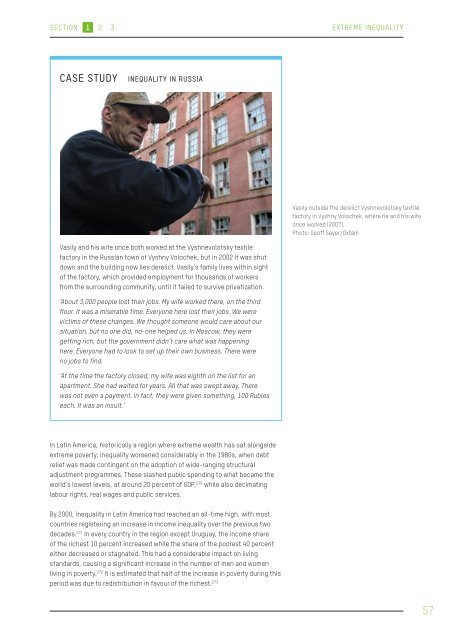1FW2e8F
1FW2e8F
1FW2e8F
You also want an ePaper? Increase the reach of your titles
YUMPU automatically turns print PDFs into web optimized ePapers that Google loves.
SECTION 1 2 3<br />
EXTREME INEQUALITY<br />
CASE STUDY<br />
INEQUALITY IN RUSSIA<br />
Vasily outside the derelict Vyshnevolotsky textile<br />
factory in Vyshny Volochek, where he and his wife<br />
once worked (2007).<br />
Photo: Geoff Sayer/Oxfam<br />
Vasily and his wife once both worked at the Vyshnevolotsky textile<br />
factory in the Russian town of Vyshny Volochek, but in 2002 it was shut<br />
down and the building now lies derelict. Vasily’s family lives within sight<br />
of the factory, which provided employment for thousands of workers<br />
from the surrounding community, until it failed to survive privatization.<br />
‘About 3,000 people lost their jobs. My wife worked there, on the third<br />
floor. It was a miserable time. Everyone here lost their jobs. We were<br />
victims of these changes. We thought someone would care about our<br />
situation, but no one did, no-one helped us. In Moscow, they were<br />
getting rich, but the government didn’t care what was happening<br />
here. Everyone had to look to set up their own business. There were<br />
no jobs to find.<br />
‘At the time the factory closed, my wife was eighth on the list for an<br />
apartment. She had waited for years. All that was swept away. There<br />
was not even a payment. In fact, they were given something, 100 Rubles<br />
each. It was an insult.’<br />
In Latin America, historically a region where extreme wealth has sat alongside<br />
extreme poverty, inequality worsened considerably in the 1980s, when debt<br />
relief was made contingent on the adoption of wide-ranging structural<br />
adjustment programmes. These slashed public spending to what became the<br />
world’s lowest levels, at around 20 percent of GDP, 270 while also decimating<br />
labour rights, real wages and public services.<br />
By 2000, inequality in Latin America had reached an all-time high, with most<br />
countries registering an increase in income inequality over the previous two<br />
decades. 271 In every country in the region except Uruguay, the income share<br />
of the richest 10 percent increased while the share of the poorest 40 percent<br />
either decreased or stagnated. This had a considerable impact on living<br />
standards, causing a significant increase in the number of men and women<br />
living in poverty. 272 It is estimated that half of the increase in poverty during this<br />
period was due to redistribution in favour of the richest. 273<br />
57


